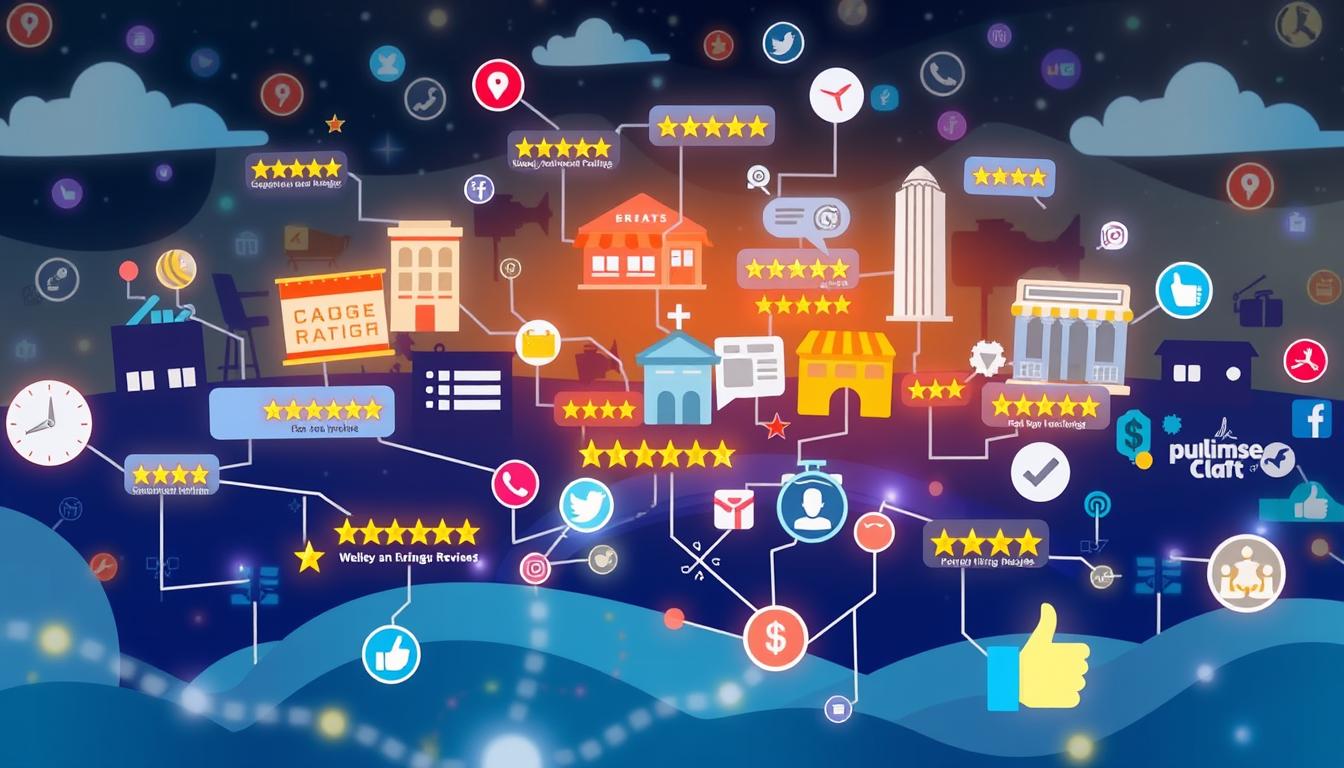Ever wondered how some brands rule the digital world? We’re going to explore successful online reputations and their secrets. From new start-ups to big names, these companies know how to build trust and keep customers coming back online.
In today’s world, being seen online is key to success. The Farmer’s Dog, for example, went from a small start-up to delivering millions of meals a month in six years1. Care/of, a company that makes personalized vitamins, got a $225 million valuation and was bought by Bayer in the same time1. These stories show how a strong online reputation can lead to big wins.
But it’s not all about growing fast. Dollar Shave Club’s first video got 4.75 million views in three months and now has over 27 million1. Casper changed the mattress game by building trust with great content marketing1.
These stories show that a strong brand is more than just selling stuff. It’s about connecting with customers, building trust, and being consistent online. We’ll look into these strategies to see what makes these companies stand out.
Key Takeaways
- A strong online reputation is crucial for business success in the digital age
- Viral content can significantly boost brand visibility and customer engagement
- Consistent content marketing strategies help build trust and customer loyalty
- Innovative approaches to customer service can set brands apart in competitive markets
- Leveraging social media effectively is key to maintaining a positive online presence
Understanding Online Reputation Management
Online reputation management is key in today’s digital world. It means keeping an eye on what people think of a brand across different platforms. Social media, what customers say, and online reviews are very important in this effort.
Many people trust online reviews as much as they do personal advice, showing how crucial it is for businesses2. When companies quickly answer to negative reviews, they often see a big jump in customer happiness3.
Social media is a big part of managing a brand’s image. Over 43% of people look at social networks to learn about brands4. And, 69% want a fast reply when they talk about a brand online4. Quick responses can make people more loyal to a brand.
Good reviews on social media can really help a brand look trustworthy to potential customers3. Having five or more positive reviews can almost quadruple the chance someone will buy something2.
| Aspect | Impact |
|---|---|
| Customer Trust | 68% perceive business as trustworthy due to positive comments |
| Purchase Decisions | 85% use internet research before buying |
| Business Loss | 20% potential new business loss from single negative article |
| Recruitment | 75% of employers research candidates online |
Being proactive in managing your online reputation can help avoid big problems. Companies that keep an eye on their online image often see fewer issues3. It’s important because one bad review on the first page of search results can lose a company over 20% of new business2.
In the end, managing your reputation is more than fixing problems. It’s about creating a strong, positive image that connects with customers and helps your business grow. Every business, from restaurants to construction companies, can gain from a well-managed online presence.
Case Studies: Successful Online Reputations
Let’s look at real examples of businesses that have done well with online reputation management. These stories show how companies turned problems into chances to grow their brand loyalty and improve customer experience.
A big restaurant chain got better online ratings by using smart reputation management. This led to more trust from customers and stronger loyalty5. A well-known executive also boosted their reputation by improving their search results through online management5.
Small businesses have also seen good results. One small business owner got more positive reviews and a stronger online presence5. This shows how good customer service and building a community can change how people see you.
In the nonprofit world, an organization built trust through reputation management. This led to more people giving money and donating, showing how being in line with customer values helps5.
Online stores have also seen big wins. One store improved their online reputation, which led to happier customers and more sales5. This proves how being proactive with customer service builds a strong online image.
About 90% of the time, online reputation management works well6. For example, harmful articles were gone in three months for an entertainment CEO, and negative links were pushed down in four months for an art gallery owner6.
These stories show how important crisis management, customer service, and building a community are for a good online reputation. By focusing on these, businesses can make their brand more loyal and improve customer experience.
Proactive Customer Service: The Zappos Approach
Zappos leads in customer service in the online shopping world. They focus on making shopping great to keep customers coming back. By 2025, making customers happy will be key for businesses in many fields7.
At Zappos, making customers happy is everything. They talk to over 5,000 people on the phone and answer 1,000 emails every week8. This shows how much they care about helping customers. They make personal connections with customers through their service8.

Zappos goes above and beyond for customers. They offer free shipping and easy returns, with a 365-day return policy8. These benefits make customers happy and spread the word about Zappos online and in the news.
“We’re not just selling shoes, we’re delivering happiness.”
Zappos values talking to customers directly, unlike many companies that use chatbots8. This personal touch makes customers feel valued and often leads to great reviews. Zappos puts more effort into making customers happy than into big marketing campaigns8.
| Zappos Customer Service Strategy | Impact |
|---|---|
| Personalized Interactions | Builds lasting customer relationships |
| 365-day Return Policy | Increases customer satisfaction and loyalty |
| Human-centric Support | Enhances customer experience |
| Free Shipping and Returns | Boosts competitive advantage |
Zappos shows that great customer service builds a strong online image. By focusing on what customers want, they’ve set a standard for making shopping a positive experience and achieving lasting success7.
Building Community and Brand Loyalty: Glossier’s Strategy
Glossier changed the beauty industry with its new way of connecting with customers and building a brand community. Since starting in 2014, this brand has grown to be worth $1.2 billion. It’s now a leader in direct-to-consumer beauty910.
Glossier’s success comes from its smart use of social media and real customer stories. It has 2.6 million followers on Instagram, making it a big name online910. The brand stands out by sharing real people’s experiences with its products. This makes potential customers trust the brand more.

Glossier doesn’t just use social media to connect with customers. It talked to thousands of women to learn what they wanted in beauty products. This has made customers more loyal to the brand11. Making products with customers has also saved money and made getting feedback faster, which has helped engage more people10.
Word of mouth has been key to Glossier’s success. About 70% of its sales and website visits come from friends telling friends about it. This includes 8% from their Instagram ambassadors9. Studies show that people are 40% more likely to buy beauty products if a friend suggests them10.
| Metric | Value |
|---|---|
| Instagram Followers | 2.6 million |
| Peer-to-Peer Referrals | 70% of online sales and traffic |
| Instagram Brand Ambassador Impact | 8% of online sales and traffic |
Glossier’s story shows how important a strong brand community is. By making customers feel like they’re part of something, Glossier has built a loyal group of fans. This group helps the brand grow in a tough beauty market.
Aligning with Customer Values: Patagonia’s Commitment

Patagonia is a top example of matching customer values. This brand is all about the environment and making customers happy. They don’t just talk about being green; they act on it, winning over eco-friendly shoppers.
The company’s growth shows it’s hitting the mark with customers. In 2012, Patagonia’s sales jumped about 30% to $543 million. Then, they added another 5% in 2013. By 2017, they hit a billion in sales12. This rise matches studies that show caring for the planet makes a brand more appealing13.
Patagonia’s green efforts are huge. In 2018, they gave $10 million to environmental groups from tax cuts. They started an eco-friendly food business and even offered credits for old Patagonia clothes12. These moves show their real commitment to the planet, building trust with customers.
Happy customers are key for Patagonia. They send trucks all over to fix outdoor gear and sell used items. Customers can return some items for credits, which get cleaned and sold on their “Worn Wear” site12. This not only cuts down on waste but also keeps customers coming back.
With over 70 stores worldwide, Patagonia’s success shows the power of matching with customer values12. Their focus on the environment and making customers happy has built a strong connection with shoppers. They’re setting new standards in retail.
Leveraging Social Media for Customer Support: Adobe’s Approach
Adobe is a tech leader with a strong online presence. In 2019, they made $11.17 billion, showing a 23.7% increase from the year before14. Their success comes from their creative way of supporting customers and listening to social media.
Adobe uses @AdobeCares on Twitter to show they care about technical support. With 6 million followers, they quickly help customers14. This helps keep customers coming back and builds loyalty to their brand.

Adobe’s social media strategy is a big hit. Their main website is ranked 13th globally, with 2 million backlinks and almost 10 million organic keywords15. These numbers show how important it is to listen to what people are saying online.
Adobe’s forum on their site gets over 15 million visits a month, with people spending about four minutes there14. This shows how using social media can really help keep customers happy.
User-generated content is very powerful. A huge 79% of people say it greatly affects what they buy, while only 13% are swayed by brand-made content14. Adobe encourages community interaction to boost loyalty and keep customers coming back.
Adobe’s use of social media and customer support is a model for other businesses. By focusing on listening and helping customers quickly, companies can make stronger bonds with their audience. This leads to long-term success.
Conclusion: Key Takeaways for Building a Strong Online Reputation
We’ve seen how top brands build trust online. They see better financial results because of it16. This success comes from careful planning and quick action.
Customer feedback is very important. Most people read online reviews before buying, and 93% let them influence their choices17. To gain trust, businesses need to listen and respond. When they do, their ratings can go up by 0.1 stars17. This small increase can really help, as 48% look for at least a 4-star rating17.
Speed is key in handling crises. Fast action helps keep a good image16. But it’s not just about fixing problems. Making valuable content and focusing on user experience are crucial for a strong online presence18. Remember, building a good reputation takes time – about six months18. Stay patient and keep at it. Your brand’s online reputation is an investment that grows customer trust and your business.
FAQ
What is online reputation management?
Why is online reputation management important for businesses?
What are the advantages of online reputation management?
What are the disadvantages of online reputation management?
What types of businesses can benefit from online reputation management?
How can businesses effectively manage online reputation during a crisis?
What are some examples of companies with strong online reputations?
How can user-generated content campaigns help with online reputation management?
How can aligning with customer values impact online reputation?
How can social media be leveraged for customer support and online reputation management?
Source Links
- 17 Ecommerce Case Studies to Inspire You – https://www.optimonk.com/ecommerce-case-studies/
- An Overview of Online Reputation Management – https://blog.reputationx.com/online-reputation-management
- The Essential Guide to Online Reputation Management – https://www.brandwatch.com/blog/online-reputation-management-explained/
- Everything you need to know about online reputation management – https://sproutsocial.com/insights/online-reputation-management/
- Online Reputation Management Success: Inspiring Case Studies – https://www.germin8.com/blog/orm-case-studi/
- Online Reputation Management Testimonials andCase Studies – https://www.recoverreputation.com/online-reputation-success-stories-and-case-studies/
- How Zappos Delivers Exceptional Customer Experience (CX) – https://www.renascence.io/journal/how-zappos-delivers-exceptional-customer-experience-cx
- Zappos case: the best customer service – https://blog.wearedrew.co/en/zappos-case-the-best-customer-service
- Glossier Marketing Breakdown: How This Beauty Brand Became a $1.2 Billion Company – https://www.optimonk.com/glossier-marketing-breakdown/
- Glossier: Disrupting the Traditional Beauty Industry – Digital Innovation and Transformation – https://d3.harvard.edu/platform-digit/submission/glossier-disrupting-the-traditional-beauty-industry/
- Emily_Butenko.pdf – https://www.theseus.fi/bitstream/10024/345001/2/Emily_Butenko.pdf
- The Success of Patagonia’s Marketing Strategy – https://www.investopedia.com/articles/personal-finance/070715/success-patagonias-marketing-strategy.asp
- Microsoft Word – final senior project.doc – https://digitalcommons.calpoly.edu/cgi/viewcontent.cgi?article=1090&context=rptasp
- Adobe’s $500 Billion Unshakeable Moat – https://foundationinc.co/lab/adobes-200-billion-unshakeable-moat/
- How Adobe Does SaaS Marketing: A Case Study – https://www.singlegrain.com/casestudies/how-adobe-does-marketing-a-case-study/
- Reputation Management Case Studies: Big Brand Turnarounds – https://bryghtpath.com/reputation-management-case-studies/
- Building a Strong Brand Presence: Strategies for Online Reputation Management – https://www.ranktracker.com/blog/building-a-strong-brand-presence-strategies-for-online-reputation-management/
- Create a Successful SEO Reputation Management Strategy for You & Your Online Business with This… – https://reputationdefender.medium.com/create-a-successful-seo-reputation-management-strategy-for-you-your-online-business-with-this-7e4eb858280c?source=rss——business_strategy-5

